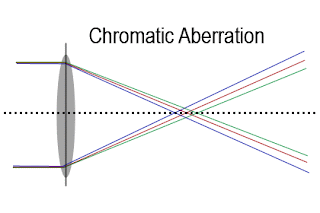First some background info:
Chromatic aberration is a kind of distortion where the lens fails to focus all component waves of the white light to a single focal point. The white light consists of component waves of color red, green, yellow, blue and violate (in their increasing order of frequencies). The refractive index of lens glass varies with the wavelength; shorter waves bends more than the longer ones. See the following diagram:
 When this happens, the sensor averages them and the edges in the image becomes distorted. See the Wikipedia page for an example. I was told that this happens mainly from the light entering closer to the edge. So, in theory, if you have a smaller aperture (i.e. later DoF value), aberration should be small. A simple technique to correct this distortion is to have a concave lens right next to the convex lens so that the effect of irregular bending of wavelength is corrected by dispersing them. But with mm focal lengths, it seems that such a simple technique does not work - it's much more difficult to correct this effect with UWA lens as they support very small focal length.
When this happens, the sensor averages them and the edges in the image becomes distorted. See the Wikipedia page for an example. I was told that this happens mainly from the light entering closer to the edge. So, in theory, if you have a smaller aperture (i.e. later DoF value), aberration should be small. A simple technique to correct this distortion is to have a concave lens right next to the convex lens so that the effect of irregular bending of wavelength is corrected by dispersing them. But with mm focal lengths, it seems that such a simple technique does not work - it's much more difficult to correct this effect with UWA lens as they support very small focal length.Test setting:
I used a Canon EOS T1i body and took multiple pictures at the same focal length (10 mm) but varying the depth of field (F values at 4/4.5/5, 5.6, 8, 11, 22, 29) at the same light condition. Here are some sample photos.
Unprocessed JPEG image for focal length = 10 mm, F = 4.0:
Unprocessed JPEG image for focal length = 10 mm, F = 11.0:
Unprocessed JPEG image for focal length = 10 mm, F = 22.0:
Note that due to the crop factor (1.6 in EOS T1i), the actual focal length is close to 16 mm.
I was expecting the CA to monotonically decrease with increasing DoF value (think in the line that with larger F values, we have smaller aperture and light will pass through mostly middle of the lens). However it was not the case. Maybe the complex inter-leaved lenses have other effects. The CA visible to the naked eye decreased 4 (highest CA), 5.6 8, 11 (lowest CA) and 11 and 16 had similar quality. At 22, CA was quite high and image quality was less than that for at 4. I am not in a position to explain this bell-curve shape like behavior. Would be very much interested to know the technical details behind the scene.
I repeated the above experiment for focal lengths 12, 14 and 16 mm. I found a similar pattern. The visible CA decreased as the F value is increased closer to the current or little above the current focal length but beyond that visible CA increased with increased F values.
So, with Sigma 10-20mm F4.0-5.6 on a Canon EOS T1i camera, if you want to take landscape photos with minimal CA, set the F value closer to the current focal length.
No comments:
Post a Comment